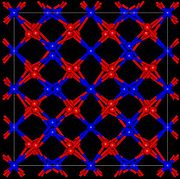
Promethium(III) oxide
Encyclopedia
Promethium oxide or promethium(III) oxide is a compound
with the formula Pm2O3. It is the most common form of promethium
.
 Promethium oxide exists in three major crystalline forms:
Promethium oxide exists in three major crystalline forms:
The low-temperature cubic form converts to the monoclinic structure upon heating to 750–800 °C, and this transition can only be reversed by melting the oxide. The transition from the monoclinic to hexagonal form occurs at 1740 °C.
Chemical compound
A chemical compound is a pure chemical substance consisting of two or more different chemical elements that can be separated into simpler substances by chemical reactions. Chemical compounds have a unique and defined chemical structure; they consist of a fixed ratio of atoms that are held together...
with the formula Pm2O3. It is the most common form of promethium
Promethium
Promethium is a chemical element with the symbol Pm and atomic number 61. It is notable for being the only exclusively radioactive element besides technetium that is followed by chemical elements with stable isotopes.- Prediction :...
.
Crystal structure

| Form | Pearson symbol Pearson symbol The Pearson symbol, or Pearson notation, is used in crystallography as a means of describing a crystal structure, and was originated by W.B. Pearson. The symbol is made up of two letters followed by a number. For example:* Diamond structure, cF8... |
Space group Space group In mathematics and geometry, a space group is a symmetry group, usually for three dimensions, that divides space into discrete repeatable domains.In three dimensions, there are 219 unique types, or counted as 230 if chiral copies are considered distinct... |
No. | a,b,c (nm) | β(deg) | Z | Density (g/cm3) |
|---|---|---|---|---|---|---|---|
| Cubic | cI80 | Ia | 206 | 1.099 | 16 | 6.85 | |
| Monoclinic | mS30 | C2/m | 12 | 1.422; 0.365; 0.891 | 100.1 | 6 | 7.48 |
| Hexagonal | hP5 | Pm1 | 164 | 0.3802; 0.3802; 0.5954 | 1 | 7.62 |
- a, b and c are lattice parameters, Z is the number of formula units per unit cell, density is calculated from X-ray data.
The low-temperature cubic form converts to the monoclinic structure upon heating to 750–800 °C, and this transition can only be reversed by melting the oxide. The transition from the monoclinic to hexagonal form occurs at 1740 °C.

